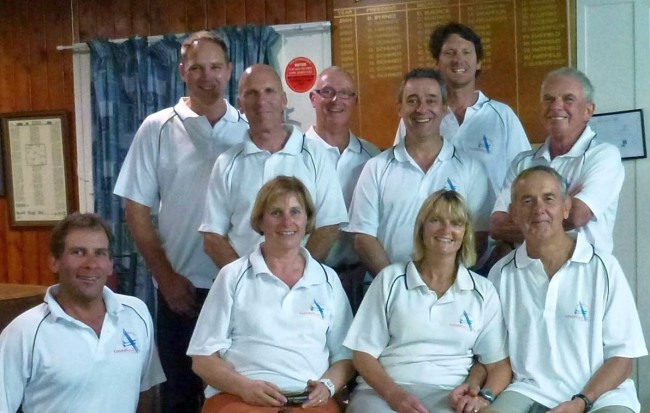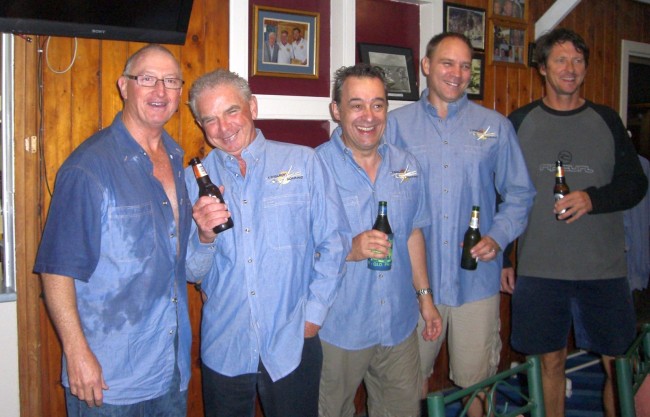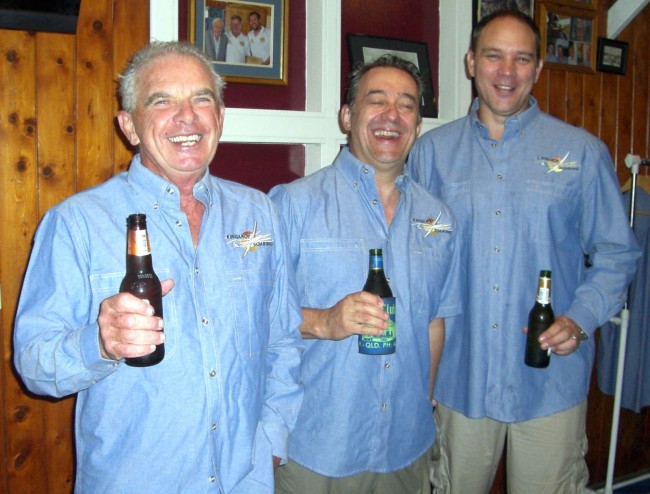For more than 10 years, Peter and Lisa Trotter have been running GlideFast to assist pilots with improving cross-country skills. The course is generally set with like-minded people, to either improve early cross-country skills, assist with flying longer distances or improve cross-country speeds for competitions. In the Kingaroy course, most pilots wanted to improve competition flying. Almost everyone had competed in at least one comp, with a state title and at least 2 nationals podium finishes in the mix. Almost every gliding club in Queensland was represented. Sandy Griffin travelled all the way from New Zealand, while Scott Percival travelled even further. He spent 4 days driving from Western Australia with his SZD 56 in tow. Scott represented Australia at the WGC in Austria, back in 1989. He has recently returned to the sport, and found many aspects of competition flying had changed.
Most of us attending Glidefast 2013 arrived on Wednesday afternoon. During the drive up, we witnessed some spectacular weather, with high bases and obviously good conditions until late in the day – 4pm (Kingaroy is in QLD, and September is still early spring, after all). While starting to rig some of the gliders, an LS10 blasted overhead in a competition finish. This was Brian Du Rieu, who had arrived early and done a 500k just to warm up before learning a few more tricks!
We had my Discus, Steve McMahon’s Mosquito, Ray Parker’s Ventus 2CX and Andres Miramontes’ LS1 rigged before settling in for a beer. Peter Trotter had arrived earlier in the day with Sandy Griffin and we were joined later that evening by Lisa Trotter, and Nev Donald the next morning.
The next day (Day 1) started with some theory on thermalling. The day was forecast to be another cracker so we headed out to fly, the objective being to achieve the longest glide between thermals and achieve the highest average climb rate. The more adventurous were to do two laps of a 150k course, while others were to do a single lap. The day delivered in spectacular fashion with 11-knot thermals to 10,500’! We whistled around the short course and all came back beaming. That evening we got to look at the traces, going through each flight. There is nowhere to hide in this, and it became evident that Peter had done significantly better than any of us plebs. His average speed of 127.5 kph was significantly higher than Brian’s 120 kph and my own 115 kph. The rest had various glitches, mostly due to new or unfamiliar navigation equipment. While they had all got round perfectly fine, the distractions had affected statistics. Even without statistics, everyone had enjoyed a great day’s gliding, which was a lot more fun than working on a typical Thursday afternoon!
Day 2 began with some more theory on Feel of the Air and Looking at Clouds. The objectives were to hone finding, centring and leaving thermals. Each day was to have a weather forecast prepared by one of the students on the course. Day 2 was my turn. XC skies and RASP both indicated reasonable conditions, though it became evident the cloud associated with the trough had not cleared as early as expected. By the time we gridded, the cloud had cleared and some high-level Cu was forming. Peter and I launched in the Duo as the ‘sniffer’ and struggled until we finally found a climb to just short of 3000’ AGL. The rest of the class duly launched, and we followed each other around for the next 90 minutes, each hoping someone could find a climb to the development that was taking place way above our heads. By 2pm it was evident the day was not going to improve, so we landed and had more discussions on gliding theory through the afternoon.
Day 3 theory was on Competition Flying and Height Bands/Speed to Fly. The objectives set for the day were to establish height bands and adjust speeds accordingly. The task was a short 100-km triangle to Wondai and Kumbia, turnpoints that would become very familiar! The day was blue and convection was working to 7,500’. On task, some of us managed to find some incredible streets of sink and fly in them for miles… Fortunately there were enough good thermals around and Peter once again demonstrated how fast the day could be flown, at 108 kph.
Day 4 theory was a little shorter, since the day was forecast to be good. The task was a reverse of the little 100-km task from Day 3. The day started quite low, convection only working to just over 5,000’. Around 2pm, convection suddenly lifted, with climbs to 8,000’ and then over 10,000’. For those going around twice, this provided an interesting mix. The first run was lower and slower, and second time around it was almost possible to final glide all the way around the 100-km course! An example of this was the Duo pairings. Sandy and Peter flew the first circuit at a modest speed, based on the weaker conditions earlier in the day. Brian then climbed into the Duo with Peter, climbed to over 6,000’ for a start and blasted around at 133 kph! This was the highest speed achieved for the course and Brian had firmly established himself as the ‘A’ student. We all donned our new crisp white ‘GlideFast’ shirts and headed to the local Chinese restaurant for a ‘final glide’ dinner. We had some great gliding and we could relax a little, since it was evident we would not be flying the next day.
Day 5 involved ground theory only, with a later and more relaxed start. Lisa presented some sports psychology theory. There was particular interest in the thoughts and attitudes of successful glider pilots. On the other hand, some people have ‘running commentary’ of their flight, which can distract. Various ways to remove distractions and enhance focus were discussed. Peter followed with a presentation on decision-making. This also proved to be very interesting, and brought up simple solutions for improving cross-country speed that are obvious once pointed out, but don’t necessarily spring to mind when intently focussed on other stuff in the air. We had a relaxing afternoon with no flying. Brian departed to pick up his wife Kim from Brisbane, but kindly left us with the proceeds of a meat raffle he won at the local RSL. Sandy coordinated a BBQ for a very grateful troop. Just as we were enjoying dessert/washing-up, a discussion started over the lightning in the distance. We casually checked the BOM and, to my alarm, noted there was a severe weather warning, with the storm due to hit in 45 minutes. We quickly checked whether there was hangar space available, and dashed out to get the gliders. Fortunately Steve and Andres had de-rigged as their solo flying for the course was over. This left just 4 gliders out in the open. As we untied, the rain started sprinkling. As we arrived at the hangars, the downpour and howling winds announced the arrival of the storm, some 20 minutes early. We managed to get 3 gliders into various hangars, thanks to the generosity of a local crop-spraying pilot Tony Pratt. Brian’s LS10 was left out, but a phone call confirmed he was securely tied down and he did have all-weather covers on to keep the airframe dry. So a very lazy day had ended in dramatic fashion. We were all soaked. Lisa took the opportunity to sell some Kingaroy shirts to various non-Kingaroy members, with photographic evidence of the turncoat treachery recorded for blackmail purposes.
Day 6 started with rain and lingering cloud. The first breaks in the cloud appeared around 11am, and the forecasts were surprisingly optimistic. XC skies was forecasting a totally blue day, which was interesting considering the early 8/8 cover we could see out the window! However, we gridded and duly launched, like a real competition. The conditions turned out to be flyable, though the wind aloft was very strong. At least one part of the forecast was correct! We had an AAT task for the day, following the presentation on flying AATs given by Peter. The first leg was into wind and was hard work. Sandy was keen to get going and was followed by Steve and Peter in the Duo, Ray Parker in his Ventus, and Nev and myself in Discuses. People got low at various times in trying conditions and some gave up on the whole crazy idea. Some of us had better luck and got around OK, including a great plucky effort by Sandy. I had an interesting final glide into a 32-kt headwind, which I won’t commit to print, but am happy to share the story over a beer! Brian had set about maximising distance in the 90 minutes available. He was dark on himself, falling 16km short of max available distance while coming home 4 minutes early. He had once again set the benchmark with an average speed of 103 kph – very impressive for the difficult conditions. After getting back, we heard Lisa had outlanded on the 3rd leg, in a soaked paddock. This demonstrated that even for the experts, sometimes Mother Nature has the last word. We all had lucky low saves during the course of the week, but with sodden ground and high winds, this last day provided little margin. No less than 6 volunteers arrived at the scene to carry the glider out of the mud. As it turned out, Lisa had parked the ’20 very close to the road, making the retrieve a piece of cake. There was not much carrying to be done after all. The only downside of placing the glider down so beautifully next to the side of the road was all the passers-by, who kept stopping to ask if she was OK!
We had a final wrap-up discussion of the day’s flying, including lessons learned. That was the end of a highly successful course. The only grumbling came from Steve’s tummy. He didn’t have time to shop for brekky/lunch before the course and ended up buying a mystery-meat sausage at the nearby vintage tractor show on a couple of days… Apparently the thermals overhead the tractor show also smelled pretty darn good.
For all of us who participated in the course, we have to pass on a huge thank-you to Peter and Lisa. They gladly give up their time to run these courses, asking nothing more than a modest fee (very modest), to cover expenses. Also a big thanks to Neil Dunn for being the designated L3 instructor, and also doing some tows. The bulk of the tows were done by Bill Hatfield, who provided some great entertainment too.
Peter and Lisa plan to expand the scope of their courses. One option is to provide cross-country training to club instructors. Instructors are the heart and soul of a club operation and the intention is to provide a suite of new tricks/skills that will in turn be passed on to newly soloed pilots. Ultimately this could help retain membership and promote wider interest in our amazing sport.









